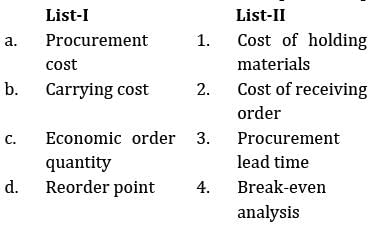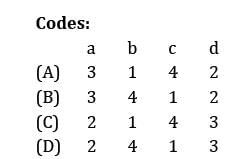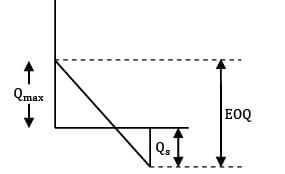Test: Inventory Control Level - 2 - Mechanical Engineering MCQ
20 Questions MCQ Test Industrial Engineering - Test: Inventory Control Level - 2
In a Wilsons model, annual demand is 10,000 units, the cost of placing an order is Rs. 500. If EOQ is 2000 units then minimum inventory cost per annum is
Match List-I with List-II and select the correct answer using the code given below the Lists:




| 1 Crore+ students have signed up on EduRev. Have you? Download the App |
There are two products A and B with the following characteristics product demand (in units), order cost (in Rs./order), holding cost (in Rs./unit/years)
A 100 100 4
B 400 100 1
The economic order quantities (EOQ) of product A and B will be in the ratio of
If the annual demand of an item becomes half, ordering cost double, holding cost one-fourth and the unit cost twice, then what is the ratio of the new EOQ and the earlier EOQ? [Assume that carrying cost depends on unit cost]
A shop owner with an annual constant demand of 'A' units has ordering costs of Rs. 'P' per order and carrying costs Rs. 'I' per unit per year. The economic order quantity for a purchasing model having no shortage may be determined from
If orders are placed once a month to meet an annual demand of 6,000 units, then the average inventory would be
The annual demand for an item is 12000 units and the ordering cost is Rs. 25/order. If the holding cost is 12% of the unit cost, then the number of orders per annum is __________ (Assume unit cost as Rs. 20)
If the orders are placed once in every two months to meet annual demand of 12,000 units. The carrying cost of inventory is Rs. 2/unit-year. What is the annual inventory cost (Rs)?
The demand for a commodity is 100 units per day. The ordering cost is Rs. 200/order and the carrying cost is Rs. 20/unit/year. If the lead time is 13 days, the re-order point is ____________
The annual demand for a product is 60,000 units, the ordering cost is Rs. 8000 per order. Considering Wilsons model, the EOQ is 12,000
units. When the annual inventory cost is minimized, the annual inventory holding cost is Rs ___________
A company has an annual demand of 3000 units, the ordering cost per order is Rs. 50 and the carrying cost is Rs. 5 per unit-year. The backorder costs are estimated as Rs. 20 per unit-year. The maximum inventory is (approximately)
Televisions are produced in batches. The production rate is 80 units/day. The demand during production period is 50 units/day. The set-up cost of manufacturing process is 3000 per set-up and holding cost is Rs. 15/unit/year. What is the economic batch size?
A manufacturing company has a contract to supply 5000 components to an automobile company per day. The manufacturing capacity of the company is 7000 components per day. The carrying cost of 1000 components is 20 paise per day. The set-up cost is Rs. 20. The total inventory cost per annum on optimum basis is __________
The annual demand for an item is 5200 units. The ordering cost is Rs. 200/order. The inventory holding cost on average inventory is 20%. The unit cost is Rs. 5 and the storage cost based on maximum inventory is 10 paise per unit per year. EOQ will be __________ units.
A company follows an EOQ system with the following data
Annual demand = 15,000 units
unit cost = Rs. 50
ordering cost = Rs. 240/order
carrying cost = 12% × unit cost
lead time = 15 days
safety stock = 150 units
The re-order level is __________ days.
In an ideal inventory control system, the economic lot size for a part is 200 units. If the annual demand for the part is increased by 4 times and carrying cost is decreased by ½, the new EOQ is __________
The demand during lead time is 250 units. The annual consumption is 4000 units. The company has a policy of EOQ ordering and maintains a buffer stock of 200 units. The reorder level is _____________ units.
Consider the following data:
Annual demand = 3000 units
Ordering cost = Rs. 100/order
Carrying cost = 25% of unit price

Optimal order quantity is
A washer manufacturing company has a contract to supply 5000 washers to an automobile industry per day. The company has a capacity to manufacture 10,000 washers/day and holding cost of one washer is Rs. 0.2 per year. Set up cost is Rs. 20. The length of the production cycle is approximately (in days) __________.
Annual consumption in ABC analysis can be represented as [D = annual demand, Q = ordering Quantity, Cu = unit cost]
|
30 videos|40 docs|30 tests
|
|
30 videos|40 docs|30 tests
|









































